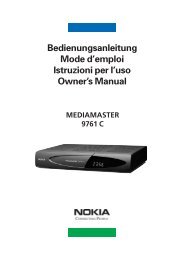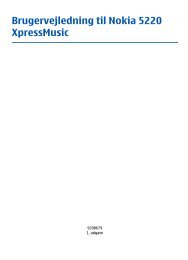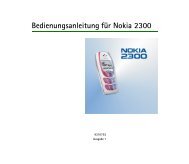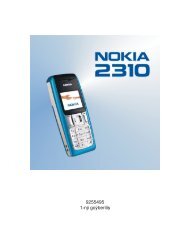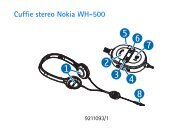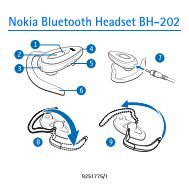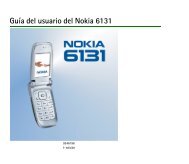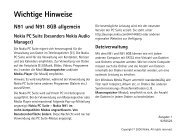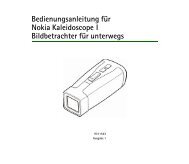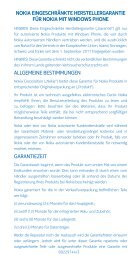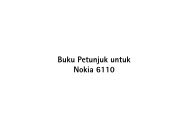Nokia E90 Communicator User Guide
Nokia E90 Communicator User Guide
Nokia E90 Communicator User Guide
Create successful ePaper yourself
Turn your PDF publications into a flip-book with our unique Google optimized e-Paper software.
S e t t i n g s<br />
Select WLAN security settings and from the following:<br />
• WEP key in use — Select the desired WEP key.<br />
• Authentication type — Select Open or Shared.<br />
• WEP key settings — Edit the settings for the WEP key.<br />
WEP key settings<br />
In the access point settings, select WLAN security mode > WEP.<br />
Select WLAN security settings > WEP key settings and from the following:<br />
• WEP encryption — Select the desired WEP encryption key length.<br />
• WEP key format — Select whether you want to enter the WEP key data in ASCII or Hexadecimal format.<br />
• WEP key — Enter the WEP key data.<br />
802.1x security settings<br />
In the access point settings, select WLAN security mode > 802.1x.<br />
802.1x authenticates and authorizes devices to access a wireless network, and prevents access if the authorization process fails.<br />
Select WLAN security settings and from the following:<br />
• WPA/WPA2 — Select EAP (Extensible Authentication Protocol) or Pre-shared key (a secret key used for device identification).<br />
• EAP plug-in settings — If you selected WPA/WPA2 > EAP, select which EAP plug-ins defined in your device to use with the<br />
access point.<br />
• Pre-shared key — If you selected WPA/WPA2 > Pre-shared key, enter the shared private key that identifies your device to<br />
the WLAN to which you connect.<br />
The settings available for editing may vary.<br />
WPA security settings<br />
In the access point settings, select WLAN security mode > WPA/WPA2.<br />
Select WLAN security settings and from the following:<br />
• WPA/WPA2 — Select EAP (Extensible Authentication Protocol) or Pre-shared key (a secret key used for device identification).<br />
• EAP plug-in settings — If you select WPA/WPA2 > EAP, select which EAP plug-ins defined in your device to use with the access<br />
point.<br />
• Pre-shared key — If you select WPA/WPA2 > Pre-shared key, enter the shared private key that identifies your device to the<br />
WLAN to which you connect.<br />
• WPA2 only mode — To enable TKIP encryption, based on transient keys changed often enough to prevent misuse, select<br />
Off. All devices in the WLAN must either allow or prevent the use of TKIP encryption.<br />
The settings available for editing may vary.<br />
EAP<br />
Select > Tools > Settings > Connection > Access points.<br />
The EAP (extensible authentication protocol) plug-ins are used in wireless networks to authenticate wireless devices and<br />
authentication servers, and the different EAP plug-ins make possible the use of various EAP methods (network service).<br />
You can view the EAP plug-ins currently installed in your device (network service).<br />
1. To define the EAP plug-in settings, select Options > New access point and define an access point that uses WLAN as a data<br />
bearer.<br />
2. Select 802.1x or WPA/WPA2 as the security mode.<br />
3. Select WLAN security settings > WPA/WPA2 > EAP > EAP plug-in settings.<br />
To use an EAP plug-in when you connect to a WLAN using the access point, select the desired plug-in and Options > Enable.<br />
The EAP plug-ins enabled for use with this access point have a check mark next to them. To not use a plug-in, select Options ><br />
Disable.<br />
To edit the EAP plug-in settings, select Options > Edit.<br />
To change the priority of the EAP plug-in settings, select Options > Raise priority to attempt to use the plug-in before other<br />
plug-ins when connecting to the network with the access point, or Options > Lower priority to use this plug-in for network<br />
authentication after attempting to use other plug-ins.<br />
See the device help for more information on EAP plugins.<br />
Data call settings<br />
Select > Tools > Settings > Connection > Data call.<br />
© 2007 <strong>Nokia</strong>. All rights reserved. 69



